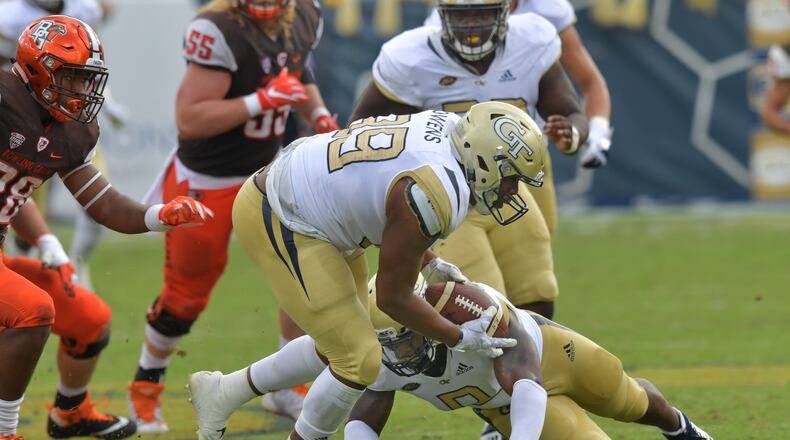As Georgia Tech defensive end Desmond Branch pressed in on a pass rush Saturday, he saw Bowling Green quarterback Jarret Doege cock his arm to throw. Knowing he wasn’t going to get to Doege, Branch did the next best thing.
Branch raised his right arm and deflected Doege’s pass with his hand, causing it to flutter into the air. Branch’s linemate Anree Saint-Amour tracked the ball and caught it just before it reached the ground, and he loped in three yards for the first interception and touchdown of his Yellow Jackets career. Branch said his reaction was developed through the week’s practice under the instruction of defensive line coach Jerome Riase, whose exhortations about Bowling Green’s propensity for throwing short routes were heeded.
“If we don’t have enough time to get a pass rush in, maybe we can do something to try to something to affect the play,” Branch said. “That’s getting our hands up.”
Tech’s Friday night game at Louisville will be the sixth of defensive coordinator Nate Woody’s tenure, and there remains plenty for the Jackets to learn. But, Tech has shown early proficiency in procuring takeaways. The Jackets have forced 10 takeaways (three by fumble, seven by interception), which is tied for 13th nationally and is as many as they created all of last season. The rate of two takeaways per game is higher than the season-ending average for eight of coach Paul Johnson’s 10 teams.
“It’s definitely nice just to get a turnover because I know last year, turnovers were hard to come by,” Branch said.
Branch got his own interception, against Clemson. After reading a play as a screen pass, Branch peeled off his pass rush to seek out the intended target and caught the ball when it deflected off an offensive lineman’s helmet.
“We’re all kind of ball hungry,” Branch said. “Like, I got a turnover, (defensive end Antwan Owens) got a turnover, now Anree got a turnover, (safety Malik Rivera) has two. It’s just like, I want to get one now.”
Such is the capacity for Tech’s defensive line to gain possession of the ball that Johnson has joked with linemen about which of the linemen is fastest with the ball. Branch took issue with Johnson’s selection of Saint-Amour.
“He didn’t have to run at all; he had no one around him,” Branch said. “He just had to catch the ball. He could have fallen; it (still) would have been a touchdown. ’Twan (Owens) ran 30 yards, he was in open space. I caught the ball among three defenders from Clemson and still ran the ball and tucked the ball when they were trying to strip it. I feel like I’m the best runner with the most situational awareness. But that’s just my opinion.”
Branch and Saint-Amour’s two picks were two of Tech’s seven thus far, which is tied for 11th nationally. Tech has recorded an interception once every 22.3 passes, the most efficient rate compared to season averages for Johnson’s first 10 teams. It was one per 55.5 passes last season.
Rivera leads with two interceptions, both off deflections to players that he wasn’t defending.
“Flying to the ball,” safety Tariq Carpenter said. “Malik had two tipped picks. I guess you can say that’s a big part of us going to the ball.”
Effort and rallying to the ball have been a hallmark of Woody’s defenses. Coaches make a weekly highlight tape of players showing all-out effort as a reminder and incentive. If players don’t make the “hustle tape,” they can’t play in the following game.
Tech and Woody have plenty of work to do still. The Jackets’ six sacks are tied for last in the ACC. Opponent third-down conversion rate (46.77 percent) is also last. Second-down defense needs work. Tech is 112th in opponent passing-efficiency rating on second down (156.47), according to cfbstats.com. Improving the play of passing-down sub packages is a priority, though it hasn’t helped that Tech has had to juggle defensive backs because of injuries, a suspension and an ejection.
“We’ve got to do a better job on second down,” Johnson said. “We’ve got to get pressure. We’ve given up too many easy throws on second down.”
Further, while the interceptions have proliferated, upcoming competition will likely be more expert. Among Tech’s final seven regular-season opponents, five are in the top 50 in passing efficiency rating. (Louisville is 120th and has thrown eight interceptions.)
But, Johnson will take the turnovers. In his tenure, Tech is 43-19 against FBS opponents when the Jackets record two or more takeaways, according to sports-reference.com.
“If you can win the turnover battle, it’ll go a long way in helping you win the game on Friday night for sure,” he said.
About the Author
Keep Reading
The Latest
Featured



